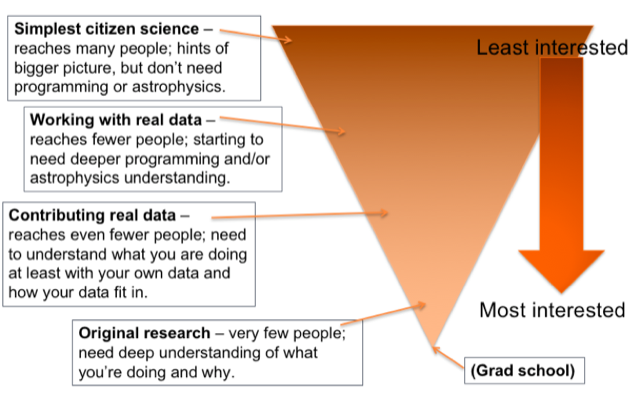The “Ecosystem” of Astronomy Education/Outreach Programs
Luisa Rebull Caltech/IPAC
Accessing high-quality astronomical data in the grade 7-12 classroom has become easier than ever before as a result of widespread internet access in schools, easily accessible professional astronomy archives (e.g., NASA’s Infrared Science Archive, IRSA, and the NASA Extragalactic Database, and NED), and research-grade robotic telescopes. This is especially important in the context of new US national science standards, which are pushing schools towards more project-based learning and authentic scientific inquiry. Demand for programs that use real data is only expected to grow. In this blog post, I suggest a funnel as a way to think about this “ecosystem” of projects getting astronomical data into the hands of teachers, students, and the public. I have fleshed out this idea in more detail in a previously published article and only summarize it briefly in this blog post.
There is a broad and dynamic “ecosystem” of programs that get astronomical data into classrooms. If you think of these diverse programs as a funnel, it is easy to see how the most interested participants at every level can be drawn further down into the funnel. I see four broad categories in this ecosystem, each with different audiences, challenges, and goals. Programs at all levels are important to the ecosystem as a whole; each has a different footprint and reaches different people.

The simplest citizen science projects reach hundreds of thousands of people, of all ages and backgrounds. Each person is doing something small to contribute to the whole. Their participation does not require a deep understanding of the bigger picture, and people are still excited that they are participating. This matters!
The most interested participants in citizen science may be interested in going further and working directly with real data. Examples of these projects include one where you rediscover Hubble’s Law with your measurements of real data; this could be a lab exercise or independent work. This variety of programs reaches fewer people and lies further down the funnel.
Even fewer people are able to contribute real data. These participants need not have access to their own telescopes (they can use web-connected telescopes), but nonetheless, their efforts add data to collective astronomical knowledge. An example might be to use a web-accessible telescope to continue monitoring a planet-hosting star and add new time series data to the existing data to find (or refine) transits. People participating in these kinds of programs have to display a deeper understanding of at least their own telescope+instrument set-up in order to be successful.
The bottom of the funnel, reserved for the most interested participants, is original research. Few people can do this, and it requires a thorough understanding of astrophysics and the technical/engineering details, at least for the topic and instrumental set-up being used.
Can you think of active astronomy education and outreach programs that exist at each of the levels of this funnel? Which level do you find most rewarding?

